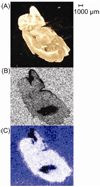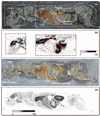Mass spectrometry imaging for drugs and metabolites
- PMID: 21515430
- PMCID: PMC3151478
- DOI: 10.1016/j.jprot.2011.03.032
Mass spectrometry imaging for drugs and metabolites
Abstract
Mass spectrometric imaging (MSI) is a powerful analytical technique that provides two- and three-dimensional spatial maps of multiple compounds in a single experiment. This technique has been routinely applied to protein, peptide, and lipid molecules with much less research reporting small molecule distributions, especially pharmaceutical drugs. This review's main focus is to provide readers with an up-to-date description of the substrates and compounds that have been analyzed for drug and metabolite composition using MSI technology. Additionally, ionization techniques, sample preparation, and instrumentation developments are discussed.
Copyright © 2011 Elsevier B.V. All rights reserved.
Figures







References
-
- Hahn EJ. Autoradiography: a review of basic principles. Am Lab. 1983;15:64–71.
-
- Svatos A. Mass spectrometric imaging of small molecules. Trends Biotechnol. 2010;28:425–434. - PubMed
-
- Reyzer ML, Hsieh Y, Ng K, Korfmacher WA, Caprioli RM. Direct analysis of drug candidates in tissue by matrix-assisted laser desorption/ionization mass spectrometry. J Mass Spectrom. 2003;38:1081–1092. - PubMed
-
- Cohen LH, Gusev AI. Small molecule analysis by MALDI mass spectrometry. Anal Bioanal Chem. 2002;373:571–586. - PubMed
Publication types
MeSH terms
Substances
Grants and funding
LinkOut - more resources
Full Text Sources
Other Literature Sources
Medical

